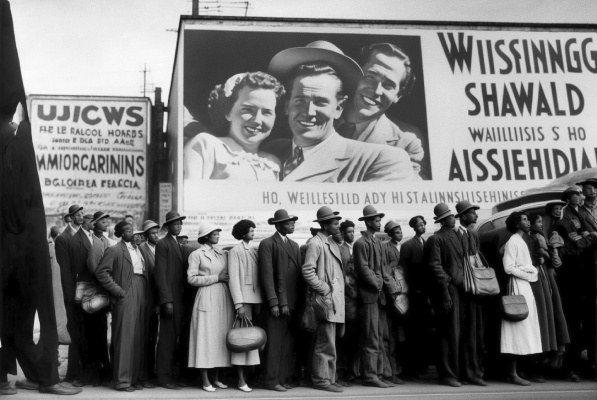Brodbeck et de Barbuat
Une histoire parallèlefrom November 9 to January 13 - 2024
print
Brodbeck et de Barbuat
Une histoire parallèle / A parallel history
November 9, 2023 - January 13, 2024
Opening Thursday, November 9, 6pm - 9pm
Following on from our recent work on computer-generated images, we thought it would be interesting to pursue this virtual approach to photography, questioning both the representation of reality and appropriation in the age of the Internet.
For this second solo show at Galerie Papillon, Brodbeck & de Barbuat propose a corpus of images that recreate a history of photography invented through a machine-learning program that generates images from textual data.
Formed in 2005 and winner of the national photographic commission Image 3.0 initiated by the Centre national des arts plastiques (Cnap) in partnership with the Jeu de Paume in 2021, the artist duo uses their mastery of the photographic medium to explore the dialogue between man and machine. A parallel story examines the emergence of creative tools using artificial intelligence and their impact on photography and its ability to make History, underlining the need to perpetually rethink our relationship with images and new technologies.
Be it a camera without a lens or with a microscope, or a virtual image without a camera at all, Brodbeck & de Barbuat have been using technology to question photography from the start. The challenge for them however is far from being just experimental. Their projects, large collections rolled out in chapters, also look for something else: nocturnal lights or deserted cities that can only be seen once captured using long exposure times (Les Mondes perdus, 2004-2008; Memories of a Silent Worlds, 2008-2012), tree bark that appears like the surface of another planet with a microscopic view (Images of Light and Dancing Spirits, 2014-2022), a computer-generated female character, neither truly human nor truly non-human (Les 1000 Vies d'Isis, 2019-2021). In these differences between perceived reality and image rendering, between documentary reference points and the strangeness of a narrative that isn’t quite a story, the same question remains : what is in the invisible material that makes up the world, life and photography ?
In Une histoire parallèle (since 2022), Brodbeck & de Barbuat this time use artificial intelligence (AI), the now-famous Midjourney, to generate a new history of photography from prompts : a sequence of keywords that AI translates into an image created from scratch, the most probable one according to what it has "learned" to associate with it- such a word equals such an image - from the immense database that is the Internet. In other words, a statistical reflection of a reality calculated according to the memory that we have all put online. After detailed research (technique, context), Brodbeck & de Barbuat described to Midjourney some 200 works from the history of the medium (Man Ray, Stephen Shore, Guy Bourdin, Andres Serrano, Jeff Wall). In many cases, they had to do a great deal of prompting, and sometimes many attempts, before AI came close to the original - enough, but not too much, to leave a few visible flaws. For some of the works, a "constellation" of attempts is exhibited, in counterpoint to others revisited in a single, small-format "AI version". Indeed, Midjourney has not mastered everything or has very definite ideas. For Peintre de la tour Eiffel, Paris (1953), in trying to do what it thought was expected, AI clearly wanted another Eiffel Tower to appear in the background, in addition to the one we could only guess at in Marc Riboud's photograph. In Étude d'après Horst P. Horst, Hands, Hands, Hands, 1941, we can only conclude that the representation of hands is not yet AI’s specialty. Nor are leaves (Taryn Simon). As for Dorothea Lange's Migrant Mother, Nipomo, California (1936), she has had some cosmetic facial work done by Midjourney's advertising bias.
But with each image there's a suggestion of confusion between what we recognize, like Martin Parr's artificial beach, and what is wrong with it. And with our struggling memories, we can't always determine exactly what it is. For while this project criticizes a new technology that undermines our perception, between the looting of works of art, the dilution of a visual heritage and aesthetic impoverishment, it is above all concerned with memory : our own, that of AI, that
of photography. Does photography make history ? What do we retain of it ? What does an AI shaped by our data retain ? Most importantly, what does the material of an image retain of reality ? Une histoire parallèle invites us to dive back into the original photographs and what inhabits them. Something indefinable is going on. Perhaps it is touching on what makes up the soul of a photograph.
Aurélie Cavanna September, 2023
Since 2005, Brodbeck & de Barbuat (FR, 1986-DE, 1981) are a Franco-German duo of photographs. Residents of the Villa Médicis, Académie de France in Rome from 2016 to 2017, they are graduated from the École nationale supérieure de la Photographie in Arles and the Institut national des langues et civilisations orientales in Paris.
Recipients of the national photographic commission Image 3.0 initiated by the CNAP in partnership with the Jeu de Paume in 2021, they received the Prix Jeune création 2013, the Prix HSBC pour la Photographie 2010 and the Prix Nestlé du Festival Images Vevey 2010.
They realized solo exhibitions at the Fotomuseum in Antwerp, the Maison Européenne de la Photographie, Villa Medici in Rome and the French Institute in Japan, and participated at group shows including the Rencontres de la Photographie in Arles, the Arsenale in Venice, the Cairo Biennale, the Saatchi gallery in London, the Museum of Photography in Thessalonica and the Mucem in Marseille. Une histoire parallèle is their second solo show at Galerie Papillon.